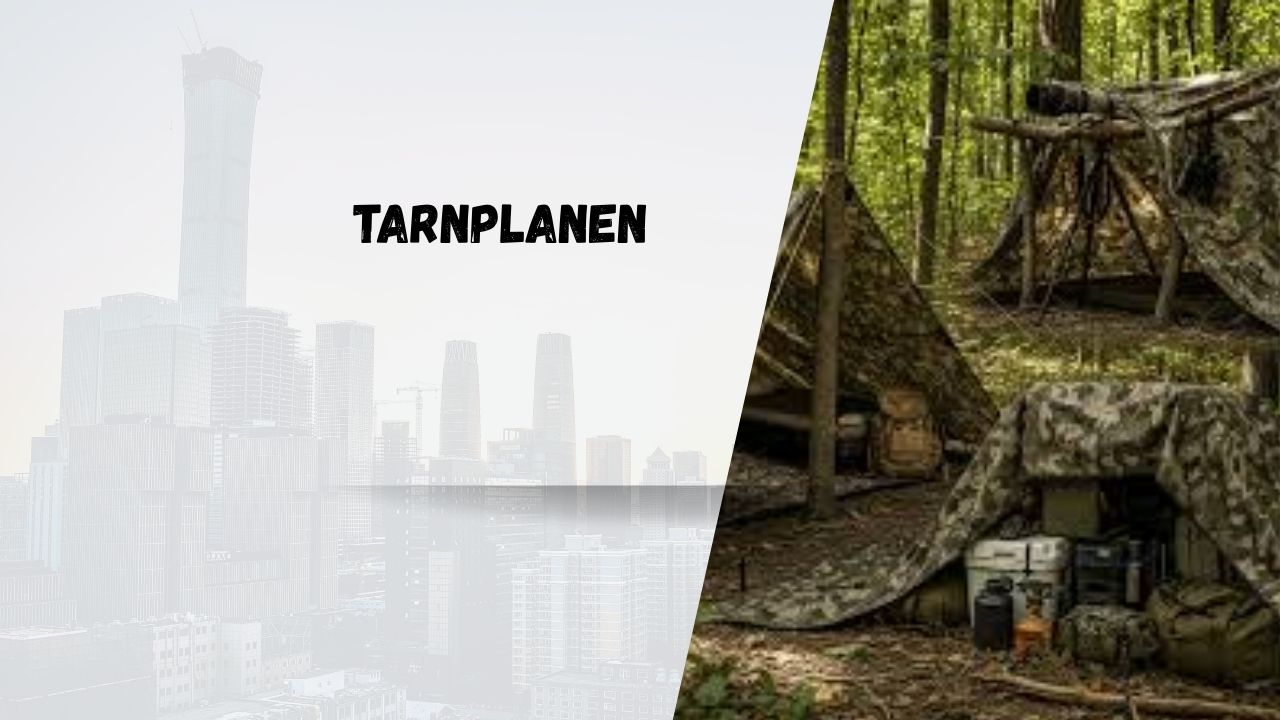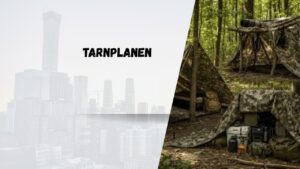Tarnplanen means camouflage tarpaulin — it’s like a big cover that helps hide and protect things. At first, armies used it in wars. Artists painted it to camouflage guns, tents, and vehicles so enemies couldn’t spot them 1914-1918-Online (WW1) EncyclopediaEncyclopedia Britannica.
Over time, regular people started using it too—hunters, campers, and folks making quick shelters in harsh weather Tarp Supply Inc.Camonets UK.
| Category | Fact / Figure |
|---|---|
| Origin of the word | From German roots. Tarn means camouflage. Planen means tarpaulin. Together—camouflage sheet. |
| First widespread use | Soldiers in World War I & II spread it over trucks, guns, even tents. It kept them hidden, safe. |
| Common materials | Nylon or polyester, light and quick to dry. Canvas, heavier but strong. PVC sheets, tough like armor. |
| Weight range | Light tarps: around 1–3 kg, easy to carry. Heavy-duty ones: 5–15 kg, depends on size and build. |
| Sizes available | Small 2×3 m, fits a pack or cover. Medium 4×6 m, works for shelter. Large 10×12 m, hides a truck. |
| Durability | Nylon lasts 3–5 years. Canvas can stretch to 5–8. PVC? With care, 8–15 years, sometimes more. |
| Weather resistance | Stops rain up to 5,000 mm. Blocks UV 80–95%. Keeps off dust, wind, sun. |
| Military use today | NATO still issues them. German Bundeswehr too. A quiet shield, still in the field. |
| Civilian use | Campers hang it between trees. Hunters crouch behind. Families use it after storms, floods, quakes. |
| Cost range | Small sheets $20–$50. Medium $60–$150. Large, military-grade—$200 and up. |
| Modern innovations | Some cut infrared glow. Some link like puzzle pieces. Some are even biodegradable. |
| Global market trend | Outdoor tarp & shelter demand grows ~6% each year. Survival gear, camping kits, keep pushing it. |
What is Tarnplanen?
Ever walked through the woods and seen how a leaf just melts into the ground? That’s kind of what tarnplanen does. The word comes from German. Tarn means camouflage, Planen means tarpaulin. Put them together and you get a camouflage tarp a sheet that hides and protects at the same time.
At first, it was built for soldiers. A way to cover trucks, guns, and gear so the enemy never saw them. But slowly, it slipped into everyday life. Hunters carried it. Campers used it. Families even kept one in the garage, just in case.
The magic is simple: concealment and protection. It hides you, or your stuff, by making it look like the world around it. And it keeps the bad weather out. Rain, dust, wind—blocked by a single sheet. That’s the beauty of it.
The Patterns
Not all places look the same, right? That’s why tarnplanen comes dressed in many skins.
- In the forest, it wears green and brown.
- In the desert, it fades into sand.
- In cities, it turns grey, black, and white.
- Some are digital, broken into tiny squares, tricking the eye.
- And in the snow, it’s pale like the ground itself.
Each one tells a story of survival. Each one says: “I don’t want to be seen.”
The Build
Tarnplanen is not just one thing it’s many. Some are light and thin, made of polyester or nylon. Easy to fold, quick to dry. Others are heavy canvas, tough but a bit stubborn to carry. Then you have the thick PVC or polyethylene ones like armor, waterproof and sunproof, strong enough to last for years.
Most of them share clever little details. Tiny rings at the edge, called grommets, so you can tie them down tight. Extra coatings that stop UV light from eating the fabric. Layers that make rain slide right off.
And here’s the trade: light ones are easy to move but don’t last forever. Heavy ones? They last, but you’ll feel the weight.
The Uses
In war, tarnplanen was a silent guard. Soldiers pulled it over tanks, radios, and supplies sometimes even themselves. It didn’t just hide them from sight; it could blur them from night vision too.
In peace, it found new jobs. A camper stretches it between two trees and suddenly has a roof. A hiker lays it on the ground and sleeps on it. A photographer waits behind it, camera ready, while animals pass by without fear.
And in disaster, after storms or floods, tarnplanen shows its kindness. Quick shelters, dry covers for food and medicine. A thin sheet standing between people and the harsh sky.
Why People Still Use It
It’s quiet. It blends. That’s stealth.
It fights rain, wind, and sun. That’s resistance.
It bends to your need tent, mat, shade, stretcher. That’s versatility.
And compared to buying ten different tools, it’s cheap. That’s smart.
So when you see one folded in someone’s backpack or tied on the roof of a truck, remember this simple sheet carries a history of war, of travel, of survival.
Modern Innovations
Tarnplanen is not stuck in the past. It keeps changing, like the world around it.
Some sheets today have infrared-reducing coatings. That means even night vision cameras struggle to pick them up. Soldiers love it, but so do people who want extra privacy outdoors.
Then there are modular systems. Instead of one big heavy tarp, you can join smaller ones together. Like Lego, but for survival gear. Build a roof, a wall, or even a whole camp if you want.
The planet matters too. So now you see eco-friendly versions. Some are made from recycled plastics. Others are biodegradable, meant to return to the earth when their job is done.
And here’s something unexpected: design. Tarnplanen isn’t just for hiding anymore. Artists use them in installations. Fashion designers cut them into jackets or bags. What once hid people now makes them stand out. Funny, isn’t it?
How to Choose the Right Tarnplanen
Not every tarnplanen is right for you. Choosing one depends on your story.
Think about size. Do you need to cover a backpack, a tent, or maybe a whole car? Bigger isn’t always better it’s heavier.
Then, material and durability. Nylon is light. Canvas is strong. PVC feels like armor. Each comes with its own trade.
Next is environment. Forest? Go green. Desert? Go sandy. Snow? Go pale. Wrong pattern, and you stand out instead of blending in.
What about portability vs. ruggedness? A hiker might want light and small. A prepper might want heavy and tough. It’s about balance.
And don’t forget the budget. Some are cheap, some are pricey. But sometimes the one that costs a little more saves you trouble later.
Practical Tips for Use
Using tarnplanen is easy. But a few tricks make it better.
For a quick shelter, tie it between two trees. Angle it so the rain slides off. Done.
For anchoring, don’t just pull at the corners. Use the grommets, tie ropes low, and spread the tension. That way it won’t flap in the wind.
For maintenance, keep it dry when you pack it. Clean mud and salt after use. A tarp that’s cared for can last years. One ignored… maybe not.
And yes, safety matters. Don’t tie it where water can pool on top. Don’t set it near fire sparks. Tarnplanen is tough, but not invincible.
Future of Tarnplanen
So, what’s next?
In the tactical world, expect smarter camo. Fabrics that fool heat sensors. Patterns that change with light. Maybe even self-healing materials one day.
In the civilian world, it’s about comfort and sustainability. Lighter packs, greener production, and gear that lasts longer without harming the planet.
And the uses? They keep expanding. From military camps to music festivals. From hunters in the forest to artists in the city. Tarnplanen, once a soldier’s secret, is now part of everyday survival, style, and even culture.
Conclusion
In the end, tarnplanen is not just a sheet of fabric. It’s a companion. It carried soldiers through wars. It kept families dry when the sky opened. It gave hunters and campers a quiet place to breathe. Its power lives in the simple promise: hide and protect.
Nothing more, but also nothing less. From that small idea came big outcomes. The military found an edge. Civilians found cheap, clever shelter. And today, artists and designers find inspiration in the same folds of cloth. Why does it last?
Because it adapts. It shifts with the environment, with new tech, with the hands that use it. Tarnplanen isn’t fading. It’s moving. From battlefield to backyard. From survival gear to culture itself.








